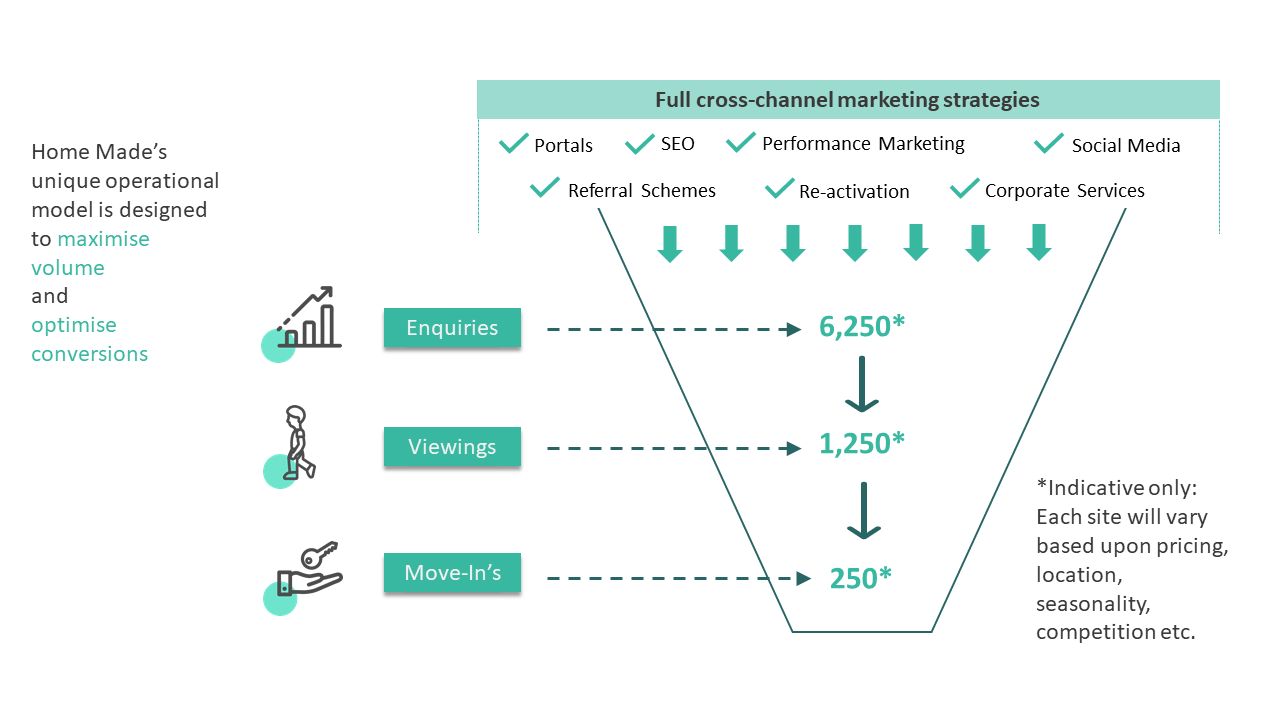The BtR paradox: part 3
- New to the UK, the BtR sector is still working to identify the right operating model to serve its residents.
- Conventional options do not serve BtR needs, as traditional agents were designed to address the requirements of a sector predominantly populated by private landlords.
- Achieve a />25% reduction in time to steady state with Home Made's proven alternative to traditional agency and in-house operating models.
- Maintain high levels of customer advocacy while optimizing your lettings operations for speed and scale.
In previous chapters of this series we have looked closely at:
- The efficacy of the marketing strategies currently relied upon by many schemes during lease up.
- Supply, demand, seasonality, and how to overcome market slumps and improve leasing velocity.
While the core objective of any developer is, obviously, to generate as many enquiries into a unit as possible, processing the volume of applicants needed to lease up on schedule creates a series of complicated logistical challenges. Unless operators have the infrastructure and personnel to convert applicants into tenancies, all of that work to optimize your marketing strategy will fail to translate into meaningful results.
Therefore, we will shift our focus in this article towards solutions that BtR funds can rely on to manage the operational complexity of letting a large volume of units in a relatively short period of time.
The Problem
A question of scale
As we explained in our previous piece, it takes thousands of unique enquiries and viewings to secure hundreds of move ins. This requires a huge team of sales and staff to manage the multiple touchpoints from initial enquiry to the offer agreed. To convert enquiries into tenancies, there are then multiple stages of tenancy administration (contracting, compliance, deposits, property accounting) to complete, requiring a significant team of support staff capable of processing several tenancies each in parallel.
In a competitive market, speed is also of the essence. Supply is high and demand is low as a consequence of Brexit and the pandemic. If a renter enquires on a property and they don’t receive a prompt response, there is no shortage of attractively priced alternatives available to them. This is also true whenever there is a natural lull in the local market.
The quality of the customer experience provided by the lettings team is equally important. This begins with the lettings process, whether under your own brand or via a third party agent. The team you hire or instruct to lease up your building has to know your brand inside out, align with your values, and represent your brand effectively to prospective residents.
Unfortunately, many of the current models that scheme operators turn to during this time-sensitive and logistically complicated stage of lease up are not adequate to the scale of the task at hand.
The traditional agency model
Just as the structural inadequacies of the branch agency model prevent it from offering a viable marketing solution for BtR schemes in need of a lease-up partner, they also render it ill-suited to the operational task of converting enquiries into tenancies.
In our previous article, we outlined the formula used to determine how many enquiries and viewings are required to reach the targeted number of move ins. To recap:
E/5:V/5:MIs
This is a general rule of thumb - not every scheme will have the same conversion rate, and leasing velocity doesn't remain stable throughout the marketing cycle. Units will let more quickly immediately after launch than several weeks later and pricing, location, and seasonality will all have an impact.
Based on this formula, for 250 tenancies you would need roughly 6250 enquiries and 1250 viewings.
In a traditional agency, a lettings negotiator will take care of the entire lettings process from point of enquiry through to offer negotiation. After the negotiated has agreed the details of an offer, this is then normally handed across to a BtR account manager, who will present the details of the offer to the client. Ongoing negotiations are then handled in parallel by the negotiator and account manager, who liaise with the renter and client respectively until an agreement is made.
Once an offer has been agreed, the tenancy administration is normally completed by an in-branch operations team. This means that one person is responsible for fielding the initial call, arranging the viewing, completing the viewing, handling the offer negotiation, and all of the follow-up communication required in between each step of the lettings journey.
Though there might be benefits from a customer experience perspective to reducing the number of points of contact throughout the lettings cycle, this model is impossible to scale. If an agent is in branch taking calls, they cannot be at the development taking viewings. If they are at the development taking viewings, they cannot be in the branch fielding new enquiries, following up after viewings, and negotiating outstanding offers. Where a new point of contact is introduced into the process (the account manager) there is little efficiency gain, as the negotiator is still handling the bulk of correspondence with the renter.
To process the thousands of enquiries it takes to lease up a scheme using this operating model, it would be necessary to hire dozens (if not hundreds - depending on their efficiency) of staff. Alternatively, operators would have to budget for a timeframe of several months, or even years, to achieve stable occupancy.
Furthermore, the commission structure used within the traditional agency model does not incentivise agents to share their pool of applicants. Therefore, agents are unlikely to work together to delegate tasks more efficiently (e.g by coordinating to ensure that someone is always on the phone while another agent is always at the development taking viewings), leaving unmitigated inefficiencies in the model at the expense of the client.
The in-house approach
Many schemes prefer to maintain control of the end-to-end customer journey by managing the full lettings process in-house. Though there are benefits to remaining the master of your own destiny, and some operators prefer to retain sole accountability for the success or failure of their development, this is an expensive and high-risk strategy.
There are two options schemes might consider when creating an in-house team of sufficient scale to manage lease up and each presents its own practical challenges. The main issue is that a building in steady state does not have the same lettings staffing requirements as a building in lease up. This means that, in order to manage the lease-up stage efficiently, a scheme can either rely on temporary staffing solutions or hire a large team of permanent employees who risk becoming largely redundant once most units are occupied.
The flexibility of temporary staffing solutions is appealing insofar as an operator can increase or reduce the number of employees operating onsite according to the stage of occupancy in a development. However, it is very difficult to build a cohesive team of temporary workers who can integrate seamlessly with permanent staff. Temporary workers will be unfamiliar with your company culture and internal processes, and there are no guarantees that they will align with your values - which is particularly risky in client-facing roles. It would require significant time and effort to ensure that they are fully trained and capable of delivering an on-brand customer journey to a high standard, which represents a substantial investment for short-term employees.
The alternative is to hire a permanent lettings team to handle the development. This option allows far greater control over the recruitment process and means that employees will have a long-term investment in the success of a scheme. The problem with this option is twofold. Firstly, leasing up a building requires significant human capital. By building an in-house lettings team, there is a very real risk of either under-hiring relative to lease-up needs or over-hiring relative to the needs of a building with stable occupancy.
If there are too few staff to manage the volume of applicants and operational complexity of the lettings process, there is a risk to the quality of the customer journey or team morale. If an operator is managing with a fairly small lettings team, then this likely means that marketing efforts are not leading to the number of enquiries and viewings needed to lease up a building before the developer incurs significant void costs.
If the in-house team is large enough to process a large number of applicants, then it is likely that many of those team members will become surplus to requirements once vacancy rates are low. This would leave the option of maintaining an expensive fixed-cost base or laying off staff, which would be devastating for team morale and come at a great personal cost for those made redundant.
Secondly, there is a risk of replicating the inefficiencies built into the traditional agency model. Hiring lettings negotiators with a traditional agency background and having them manage the customer journey from enquiry to offer agreed will yield similar results to simply instructing a third-party agent to handle the lettings process. While in-house negotiators will be on-brand and easier to subject to oversight for quality control, it will take an unreasonably long time to achieve high occupancy rates using this poorly adapted operating model.
The solution
As the traditional model of atomised lettings negotiators managing the bulk of the process individually isn’t built for scale, the solution is to delegate different stages of the lettings journey to separate teams.
At Home Made, this is how we are able to process high volumes of applicants on behalf of our clients. From our central office, we have a large team of experienced sales staff dedicated solely to responding to enquiries, a separate team of sales associates who focus mainly on viewings, and dedicated business account managers who negotiate offers on behalf of our clients. Applicants are qualified at each stage to confirm their suitability, and our proprietary quality control metrics are used to benchmark our team against objective standards and ensure consistency across the customer journey.

By breaking the lettings journey down into its constituent components and building a team for each step of the process, our model offers the only solution that can be scaled to suit the needs of a development during lease up. We can handle several times the number of calls and viewings per day compared with either a traditional agent or an in-house lettings team, and, with the help of smart technology, our operations team can process a far higher number of transactions per person by comparison with alternative solutions.
It is challenging to recruit and train different teams to handle separate parts of the process while ensuring consistency of service and message, and introducing more handover points into the process requires diligent oversight and quality control. Nevertheless, we succeed at doing just that.
Our score of 4.7 on Trustpilot is evidence of the quality of customer experience we provide. Renters are happy to deal with multiple points of contact provided the process is efficient and the standard of service is consistently exceptional across the entire team. We invest heavily in structured training and maintain an obsessive focus on company culture and quality control to guarantee that this is the case.
Reviews such as the below are common, with renters shouting out multiple Home Made team members in testimonials they are happy to provide after working with our outstanding sales and operations staff:

If executed correctly, our assembly line model is the only operational strategy that can deliver at the scale, speed, and standard necessary to ensure BtR operators hit their top-line targets during lease up. Whereas a negotiator operating in a traditional agency can complete 3-4 viewings on a good day, our sales associates complete 8-10 as standard with zero compromise to the quality of the renter’s customer journey. This is how we can help schemes to achieve a 25% reduction in time to stabilisation compared with their original projections.
We are, as always, here to help and if you want to speak to us about how we can support the lease-up of your scheme get in touch with Jo Green for a bespoke proposal.
Check out more of our articles here and follow us on Twitter, LinkedIn, Instagram, and Facebook for regular insights on the industry, market news, and company updates from Home Made.




